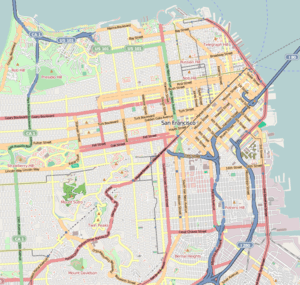Western Addition, San Francisco
Coordinates: 37°46′57.07″N 122°25′41.7″W / 37.7825194°N 122.428250°W
| Western Addition | |
|---|---|
| Neighborhood of San Francisco | |
|
A southern view from Alta Plaza Park, which is in the Pacific Heights neighborhood. Most of the valley in the central part of this image is in the Western Addition neighborhood. | |
 Western Addition Location within Central San Francisco | |
| Coordinates: 37°46′57″N 122°25′42″W / 37.782472°N 122.428315°W | |
| Government | |
| • Supervisor | London Breed |
| • State Assembly | David Chiu (D) and Phil Ting (D)[1] |
| • State Senator | Scott Wiener (D)[1] |
| • U. S. Rep. | Nancy Pelosi (D)[2] |
| Area[3] | |
| • Total | 1.20 km2 (0.463 sq mi) |
| • Land | 1.20 km2 (0.463 sq mi) |
| Population (2008)[3] | |
| • Total | 12,934 |
| • Density | 10,780/km2 (27,919/sq mi) |
| ZIP Code | 94102, 94109, 94115, 94117 |
| Area codes | 415/628 |
| [3] | |
The Western Addition is a neighborhood in San Francisco, California, United States.
Location
The Western Addition is located between Van Ness Avenue, the Richmond District, the Haight-Ashbury and Lower Haight neighborhoods, and Pacific Heights.
Historically, the Western Addition was first platted during the 1850s as a result of the Van Ness Ordinance. This large tract encompassed some 500 blocks running west from Larkin Street (the city's previous western boundary) to Divisadero Street (hence the name "Western Addition"). The area was initially used for small-scale farming, but following the invention of the cable car during the 1870s, the Western Addition developed as a Victorian streetcar suburb. It survived the 1906 San Francisco earthquake with its Victorian-style buildings largely intact.
Today, the term Western Addition is generally used in two ways: to denote the development's original geographic area, or to denote the eastern portion of the neighborhood (also called the Fillmore District) that was redeveloped in the 1950s.
Those who use the term in the former sense generally consider its boundaries to be Van Ness Avenue on the east, Masonic on the west, California Street on the north, and Fell or Oak Street on the south. From there, it is usually divided into smaller neighborhoods such as Lower Pacific Heights, Cathedral Hill, Japantown, the Fillmore, Hayes Valley, Alamo Square, Anza Vista, and North Panhandle.
The San Francisco Association of Realtors defines the term more closely to the latter sense, treating it as "District 6D" (not to be confused with Board of Supervisors districts; much of the Western Addition is in supervisors District 5), bounded by Geary Boulevard in the north, McAllister and Fulton streets, and Golden Gate Avenue on the south, Van Ness Avenue in the east, and Divisadero Street on the west. By this definition, the Western Addition is roughly synonymous with the Fillmore and Cathedral Hill neighborhoods.[4]
After the Second World War, the Western Addition — particularly the Fillmore District — became a population base and a cultural center for San Francisco's African American community. Since then, urban renewal schemes and San Francisco's changing demographics have led to major changes in the economic and ethnic makeup of the neighborhood, as the Fillmore District suffered from crime and poverty while many other districts underwent significant gentrification.
The Central Freeway used to run through the neighborhood to Turk Street, but that section of the freeway was closed immediately after the 1989 Loma Prieta earthquake and later demolished.
Since the early 1990s, the Western Addition has undergone massive gentrification.
Government and infrastructure
The San Francisco Police Department Northern Station serves the Western Addition.[5]
Notes
- 1 2 "Statewide Database". UC Regents. Retrieved December 8, 2014.
- ↑ "California's 12th Congressional District - Representatives & District Map". Civic Impulse, LLC.
- 1 2 3 Western Addition neighborhood in San Francisco, California (CA), 94102, 94109, 94115, 94117 subdivision profile - real estate, apartments, condos, homes, community, population...
- ↑ District 6 Central North
- ↑ "Northern Station." (Archive) San Francisco Police Department. Retrieved on September 1, 2013.
See also
| Wikimedia Commons has media related to Western Addition, San Francisco. |
External links
-
 San_Francisco/Western Addition travel guide from Wikivoyage
San_Francisco/Western Addition travel guide from Wikivoyage

.svg.png)